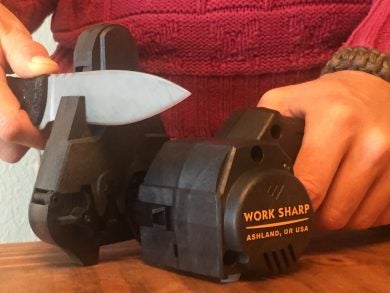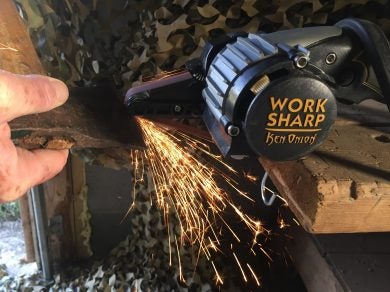WorkSharp Power Sharpener: zap the dull on blades large or small
AllOutdoor Staff 11.06.18

Recently, I reported on a test of some field-friendly hand tools from Oregon-based blade sharpening company, WorkSharp. That was the tamer side of their product line. This time, we went for the faster side of the company’s lineup test drove their two electric-powered sharpening machines.
As a newbie to power sharpening tools, my questions were many. What objects can be sharpened? How do these machines perform compared to manual sharpening? Why would a person want or need an electric sharpener? Admittedly, the most pressing question was an anxious one: Would using an electric sharpener deliver even a glimmer of the satisfaction I derive from the deliberate, slow process of manual sharpening? I’d soon find out.
These tools are scaled-down versions of industrial knife sharpeners, bringing the ability to professionally sharpen most blades into your home. These two units have more in common than not. Both come in a shoebox-size package. They both use a series of abrasive or polishing belts on small pulleys—these flexible grinding surfaces are a trick borrowed from the toolbox of professional blade-making, to create a super-sharp edge. Each has a heavy-duty, two-prong power cord and grip-operated switch. They differ in a couple ways that may influence a purchaser one way or another. Let’s take a look at each:
The slightly smaller tool, Original Tool and Knife Sharpener appears to be WorkSharp’s product, manufactured by their parent company, Darex. This tabletop sharpener comes with two each of coarse, medium, and fine grit belts. Guides for large kitchen and hunting blades are set at 25 degrees per side. Thinner blades can be honed at 20 degrees per side, using the beveled guides provided. Assuming the operator does their job correctly by holding the blade against the guide so its weight rests on the moving belt, moving the blade at the rate of an inch per second, a perfect edge is in sight for all but the hardest steel. The unit will file larger tools, up to lawmower blades. A scissor guide, with a magnet to hold the blade against the guide, helps hone the perfect edge on those worn shears.

A new release by WorkSharp, a similar but slightly larger unit, is name-branded by celebrated blade designer Ken Onion. The Ken Onion Edition Knife and Tool Sharpener has a rotating, adjustable grinding head and removable guides.



In addition to greater adjustability, the Ken Onion Edition sharpener can be bolted to a table for stability while working on large blades. This is a necessity if you don’t have a partner to hold the machine down in use—it’s a bit more powerful than the Original sharpener, and it will move! It also has an adjustable-speed motor to customize the work done on smaller (lower speed) versus large (faster motor speed) blades. This upgraded sharpener is not quite ready for all-day commercial work, however it does handle constant and heavy grinding without heating up in comparison to the Original model.
Serrated blades are notoriously difficult to sharpen. The Ken Onion unit has a section specifically for serrated edges. The machines restored my set of finely serrated kitchen knives to their original fair sharpness as compared to the dangerously dull state they were in.
Setting up and using either machine takes some time and practice in the beginning. The instruction manuals suggest not trying to sharpen one’s best blades at first; there is a learning curve. Maintaining just the right angle and keeping the blade moving steadily while holding it against the guide, and powering the unit off as the point reaches halfway on the belt, takes concentration, especially for curved blades. Once a routine is established, it’s very rewarding to watch an edge take on a new sheen, feel the new burr that’s raised on the yet-unsharpened side, and then feel the smooth edge form on the second side in place of the burr, followed by a final honing for sharpness with the fine-grit belts.

All the blades in this test showed at least some improvement in sharpness. Remarkable among them were an axe and a fixed-blade daily carry knife. A very aged, dull axe was sharpened with the Ken Onion model, after some practice with smaller knives. This axe is still in use for splitting kindling, or at least I try to use it—results have been short of satisfactory. When put to the belt grinder, amazingly, a bright sheen appeared where there had been dullness after just three swipes. After a tuning with a fine-grit belt, it was off to see if the little axe would do better than its usual bouncing off the wood. The new edge meets muster, cutting into woodgrain like I’ve never seen it do. At this rate, it’ll be good for double its already 60-plus year old life.
The star performer on the Original model was a fixed blade knife by Buck Knives, which I didn’t have high hopes for. This knife had been used in dusty, gritty conditions as a utility blade, and was rather dull. I put it through the paces with the Original—five strokes per side with the medium, then the fine grit belts. My first clue that this would be special is when it got immediate traction on my thumbnail on the classic blade-to-nail test. For kicks, I sliced into a tomato, and was astounded. The blade cut like butter—smoother than some quite pricey fighting knives we’d also sharpened. I decided to see how thin it would slice tomatoes, and it cut them so easily into transparent little layers—so many, I got tired of cutting! A truly impressive result. Having done some research into this blade using the manufacturer’s website and this excellent resource on types of steel by BladeHQ, I understand this knife to be one that does sharpen easily, thanks to relatively soft steel, and that I can’t expect it to keep this stunningly sharp edge for long under use. But, the initial result of sharpening is undeniably impressive.

Using these sharpeners in conjunction with the BladeHQ guide, when it’s possible to know the type of steel I’m sharpening, has been quite an education of its own. As mentioned in a review of WorkSharp’s manual sharpeners, sharpening can be an almost meditative exercise, one that yields an almost instant reward for relatively little effort. Once comfortable with the correct operation of these electric sharpeners, the methodical process brings a certain, almost primal sort of satisfaction as one develops an understanding of coaxing the best edge out of various types of steel and blade designs.
Primal satisfaction through sharpening is affordable for the common person with WorkSharp’s products. The Original Knife and Tool Sharpener is ready for occasional duty for $89.95. Those with a heavier sharpening workload, especially those that regularly include large jobs like mower blades, should spring for the robust, option-rich Ken Onion Edition, currently on sale for $129.95; it’s regularly $20 more. Either one is a bargain considering the improved productivity and safety of well-sharpened, regularly maintained blades. I would be proud to give or receive either of these units as a gift.